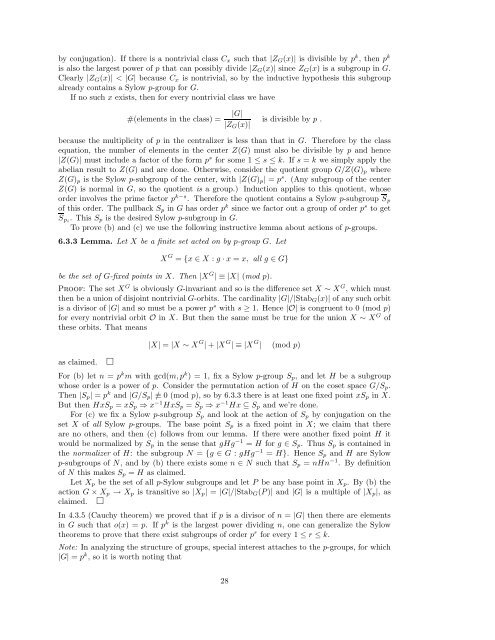Algebra I: Section 6. The structure of groups. 6.1 Direct products of ...
Algebra I: Section 6. The structure of groups. 6.1 Direct products of ...
Algebra I: Section 6. The structure of groups. 6.1 Direct products of ...
Create successful ePaper yourself
Turn your PDF publications into a flip-book with our unique Google optimized e-Paper software.
y conjugation). If there is a nontrivial class Cx such that |ZG(x)| is divisible by p k , then p k<br />
is also the largest power <strong>of</strong> p that can possibly divide |ZG(x)| since ZG(x) is a subgroup in G.<br />
Clearly |ZG(x)| < |G| because Cx is nontrivial, so by the inductive hypothesis this subgroup<br />
already contains a Sylow p-group for G.<br />
If no such x exists, then for every nontrivial class we have<br />
#(elements in the class) = |G|<br />
|ZG(x)|<br />
is divisible by p .<br />
because the multiplicity <strong>of</strong> p in the centralizer is less than that in G. <strong>The</strong>refore by the class<br />
equation, the number <strong>of</strong> elements in the center Z(G) must also be divisible by p and hence<br />
|Z(G)| must include a factor <strong>of</strong> the form p s for some 1 ≤ s ≤ k. If s = k we simply apply the<br />
abelian result to Z(G) and are done. Otherwise, consider the quotient group G/Z(G)p where<br />
Z(G)p is the Sylow p-subgroup <strong>of</strong> the center, with |Z(G)p| = p s . (Any subgroup <strong>of</strong> the center<br />
Z(G) is normal in G, so the quotient is a group.) Induction applies to this quotient, whose<br />
order involves the prime factor p k−s . <strong>The</strong>refore the quotient contains a Sylow p-subgroup Sp<br />
<strong>of</strong> this order. <strong>The</strong> pullback Sp in G has order p k since we factor out a group <strong>of</strong> order p s to get<br />
Spi. This Sp is the desired Sylow p-subgroup in G.<br />
To prove (b) and (c) we use the following instructive lemma about actions <strong>of</strong> p-<strong>groups</strong>.<br />
<strong>6.</strong>3.3 Lemma. Let X be a finite set acted on by p-group G. Let<br />
X G = {x ∈ X : g · x = x, all g ∈ G}<br />
be the set <strong>of</strong> G-fixed points in X. <strong>The</strong>n |X G | ≡ |X| (mod p).<br />
Pro<strong>of</strong>: <strong>The</strong> set X G is obviously G-invariant and so is the difference set X ∼ X G , which must<br />
then be a union <strong>of</strong> disjoint nontrivial G-orbits. <strong>The</strong> cardinality |G|/|StabG(x)| <strong>of</strong> any such orbit<br />
is a divisor <strong>of</strong> |G| and so must be a power p s with s ≥ 1. Hence |O| is congruent to 0 (mod p)<br />
for every nontrivial orbit O in X. But then the same must be true for the union X ∼ X G <strong>of</strong><br />
these orbits. That means<br />
as claimed. �<br />
|X| = |X ∼ X G | + |X G | ≡ |X G | (mod p)<br />
For (b) let n = p k m with gcd(m, p k ) = 1, fix a Sylow p-group Sp, and let H be a subgroup<br />
whose order is a power <strong>of</strong> p. Consider the permutation action <strong>of</strong> H on the coset space G/Sp.<br />
<strong>The</strong>n |Sp| = p k and |G/Sp| ≡/ 0 (mod p), so by <strong>6.</strong>3.3 there is at least one fixed point xSp in X.<br />
But then HxSp = xSp ⇒ x −1 HxSp = Sp ⇒ x −1 Hx ⊆ Sp and we’re done.<br />
For (c) we fix a Sylow p-subgroup Sp and look at the action <strong>of</strong> Sp by conjugation on the<br />
set X <strong>of</strong> all Sylow p-<strong>groups</strong>. <strong>The</strong> base point Sp is a fixed point in X; we claim that there<br />
are no others, and then (c) follows from our lemma. If there were another fixed point H it<br />
would be normalized by Sp in the sense that gHg −1 = H for g ∈ Sp. Thus Sp is contained in<br />
the normalizer <strong>of</strong> H: the subgroup N = {g ∈ G : gHg −1 = H}. Hence Sp and H are Sylow<br />
p-sub<strong>groups</strong> <strong>of</strong> N, and by (b) there exists some n ∈ N such that Sp = nHn −1 . By definition<br />
<strong>of</strong> N this makes Sp = H as claimed.<br />
Let Xp be the set <strong>of</strong> all p-Sylow sub<strong>groups</strong> and let P be any base point in Xp. By (b) the<br />
action G × Xp → Xp is transitive so |Xp| = |G|/|StabG(P)| and |G| is a multiple <strong>of</strong> |Xp|, as<br />
claimed. �<br />
In 4.3.5 (Cauchy theorem) we proved that if p is a divisor <strong>of</strong> n = |G| then there are elements<br />
in G such that o(x) = p. If p k is the largest power dividing n, one can generalize the Sylow<br />
theorems to prove that there exist sub<strong>groups</strong> <strong>of</strong> order p r for every 1 ≤ r ≤ k.<br />
Note: In analyzing the <strong>structure</strong> <strong>of</strong> <strong>groups</strong>, special interest attaches to the p-<strong>groups</strong>, for which<br />
|G| = p k , so it is worth noting that<br />
28

















